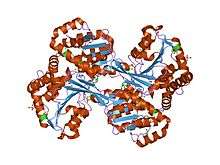Histidinol dehydrogenase
In enzymology, a histidinol dehydrogenase (HIS4) (HDH) (EC 1.1.1.23) is an enzyme that catalyzes the chemical reaction
- L-histidinol + 2 NAD+ L-histidine + 2 NADH + 2 H+
| histidinol dehydrogenase | |||||||||
|---|---|---|---|---|---|---|---|---|---|
| Identifiers | |||||||||
| EC number | 1.1.1.23 | ||||||||
| CAS number | 9028-27-7 | ||||||||
| Databases | |||||||||
| IntEnz | IntEnz view | ||||||||
| BRENDA | BRENDA entry | ||||||||
| ExPASy | NiceZyme view | ||||||||
| KEGG | KEGG entry | ||||||||
| MetaCyc | metabolic pathway | ||||||||
| PRIAM | profile | ||||||||
| PDB structures | RCSB PDB PDBe PDBsum | ||||||||
| Gene Ontology | AmiGO / QuickGO | ||||||||
| |||||||||
| Histidinol dehydrogenase | |||||||||
|---|---|---|---|---|---|---|---|---|---|
 the l-histidinol dehydrogenase (hisd) structure implicates domain swapping and gene duplication. | |||||||||
| Identifiers | |||||||||
| Symbol | Histidinol_dh | ||||||||
| Pfam | PF00815 | ||||||||
| Pfam clan | CL0099 | ||||||||
| InterPro | IPR012131 | ||||||||
| PROSITE | PDOC00534 | ||||||||
| SCOPe | 1k75 / SUPFAM | ||||||||
| |||||||||
Thus, the two substrates of this enzyme are L-histidinol and NAD+, whereas its 3 products are L-histidine, NADH, and H+.
This enzyme belongs to the family of oxidoreductases, specifically those acting on the CH-OH group of donor with NAD+ or NADP+ as acceptor. The systematic name of this enzyme class is L-histidinol:NAD+ oxidoreductase. This enzyme is also called L-histidinol dehydrogenase.
Histidinol dehydrogenase catalyzes the terminal step in the biosynthesis of histidine in bacteria, fungi, and plants, the four-electron oxidation of L-histidinol to histidine.
In 4-electron dehydrogenases, a single active site catalyses 2 separate oxidation steps: oxidation of the substrate alcohol to an intermediate aldehyde; and oxidation of the aldehyde to the product acid, in this case His.[1] The reaction proceeds via a tightly- or covalently-bound inter-mediate, and requires the presence of 2 NAD molecules.[1] By contrast with most dehydrogenases, the substrate is bound before the NAD coenzyme.[1] A Cys residue has been implicated in the catalytic mechanism of the second oxidative step.[1]
In bacteria HDH is a single chain polypeptide; in fungi it is the C-terminal domain of a multifunctional enzyme which catalyses three different steps of histidine biosynthesis; and in plants it is expressed as a nuclear encoded protein precursor which is exported to the chloroplast.[2][3][4]
Co-regulation of the gene
Histodinol dehydrogenase gene (HIS4) has been shown co-regulating the adjacent gene while it is under amino acids selective pressure.[5]
Structural studies
As of late 2007, 4 structures have been solved for this class of enzymes, with PDB accession codes 1K75, 1KAE, 1KAH, and 1KAR.
References
- Grubmeyer CT, Gray WR (August 1986). "A cysteine residue (cysteine-116) in the histidinol binding site of histidinol dehydrogenase". Biochemistry. 25 (17): 4778–84. doi:10.1021/bi00365a009. PMID 3533140.
- Nagai A, Ward E, Beck J, Tada S, Chang JY, Scheidegger A, Ryals J (May 1991). "Structural and functional conservation of histidinol dehydrogenase between plants and microbes". Proc. Natl. Acad. Sci. U.S.A. 88 (10): 4133–7. doi:10.1073/pnas.88.10.4133. PMC 51612. PMID 2034659.
- Cowan-Jacob SW, Rahuel J, Nagai A, Iwasaki G, Ohta D (November 1996). "Crystallization and preliminary crystallographic analysis of cabbage histidinol dehydrogenase". Acta Crystallogr. D. 52 (Pt 6): 1188–90. doi:10.1107/S0907444996008396. PMID 15299582.
- Barbosa JA, Sivaraman J, Li Y, Larocque R, Matte A, Schrag JD, Cygler M (February 2002). "Mechanism of action and NAD+-binding mode revealed by the crystal structure of L-histidinol dehydrogenase". Proc. Natl. Acad. Sci. U.S.A. 99 (4): 1859–64. doi:10.1073/pnas.022476199. PMC 122284. PMID 11842181.
- http://www.degruyter.com/view/j/afpuc.2015.62.issue-2/afpuc-2015-0031/afpuc-2015-0031.xml
Further reading
- Adams E (1954). "Enzymatic synthesis of histidine from histidinol". J. Biol. Chem. 209 (2): 829–846. PMID 13192138.
- Adams E (1955). "L-Histidinal, a biosynthetic precursor of histidine". J. Biol. Chem. 217 (1): 325–344. PMID 13271397.
- Yourno J, Ino I (1968). "Purification and crystallization of histidinol dehydrogenase from Salmonella typhimurium LT-2". J. Biol. Chem. 243 (12): 3273–6. PMID 4872177.
- Loper JC (1968). "Histidinol dehydrogenase from Salmonella typhimurium Crystallization and composition studies". J. Biol. Chem. 243 (12): 3264–72. PMID 4872176.